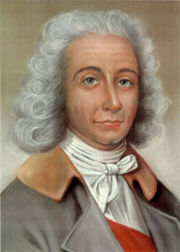
Jacques-Pierre de Taffanel de la Jonquière, Marquis de la Jonquière
Encyclopedia

New France
New France was the area colonized by France in North America during a period beginning with the exploration of the Saint Lawrence River by Jacques Cartier in 1534 and ending with the cession of New France to Spain and Great Britain in 1763...
from March 1, 1746 until his death in 1752.
De la Jonquière was born near Albi. He joined the navy when he was twelve, and fought under the Duguay-Trouin
René Duguay-Trouin
René Trouin, Sieur du Gué, usually called René Duguay-Trouin, was a famous French corsair of Saint-Malo. He had a brilliant privateering and naval career and eventually became "Lieutenant-General of the Naval Armies of the King" , and a Commander in the Order of Saint-Louis...
and in the Battle of Toulon
Battle of Toulon (1744)
The naval Battle of Toulon or Battle of Cape Sicié took place on 22 February 1744 in the Mediterranean Sea off the coast of Toulon, France. A combined Franco-Spanish fleet fought off Britain's Mediterranean fleet...
.
In 1746, he sailed on the famous and ill-fated Duc d'Anville Expedition
Duc d'Anville Expedition
The Duc d'Anville Expedition was sent from France to recapture peninsular Acadia . The expedition was the largest military force ever to set sail for the New World prior to the American Revolution. The effort to take the Nova Scotian capital, Annapolis Royal was also supported on land by a force...
.
In 1747, after a brave defence, he was defeated in the Battle of Cape Finisterre
First battle of Cape Finisterre (1747)
The First Battle of Cape Finisterre saw 14 British ships of the line under Admiral George Anson attack a French 30-ship convoy commanded by Admiral de la Jonquière during the War of the Austrian Succession. The British captured 4 ships of the line, 2 frigates and 7 merchantmen, in a five-hour...
by George Anson
George Anson, 1st Baron Anson
Admiral of the Fleet George Anson, 1st Baron Anson PC, FRS, RN was a British admiral and a wealthy aristocrat, noted for his circumnavigation of the globe and his role overseeing the Royal Navy during the Seven Years' War...
.
As Governor General, he was considered to be a good administrator if not the bravest of men in the political and economic upheavals ot the time. The opposite was true of his naval career where his twenty-nine campaigns and nine combats showed a man of great courage.
It is widely believed that de la Jonquière personally profited from the monopoly which governed the fur trade
Fur trade
The fur trade is a worldwide industry dealing in the acquisition and sale of animal fur. Since the establishment of world market for in the early modern period furs of boreal, polar and cold temperate mammalian animals have been the most valued...
at the time, even though his administrative position should have caused him to abstain from that type of commercial activity. He did use his considerable military skills to build up the military strength of New France in the face of an increasing British
Kingdom of Great Britain
The former Kingdom of Great Britain, sometimes described as the 'United Kingdom of Great Britain', That the Two Kingdoms of Scotland and England, shall upon the 1st May next ensuing the date hereof, and forever after, be United into One Kingdom by the Name of GREAT BRITAIN. was a sovereign...
threat.
See also
- Fort RouilléFort RouilléFort Rouillé or Fort Toronto was a French trading post located in Toronto, Ontario, Canada, that was established around 1750 but abandoned in 1759. The fort site is now part of the public lands of Exhibition Place...
- Toronto Fort he established (1750). - Fort BeauséjourFort BeauséjourFort Beauséjour, was built during Father Le Loutre's War from 1751-1755; it is located at the Isthmus of Chignecto in present-day Aulac, New Brunswick, Canada...
- Fort in Acadia at the head of the Bay of Fundy (1750). - Fort BeauharnoisFort BeauharnoisFort Beauharnois was a French fort built on the shores of Lake Pepin, a wide part of the upper Mississippi River, in 1727. The location chosen was on lowlands and the fort was rebuilt in 1730 on higher ground. It was the site of the first Roman Catholic chapel in Minnesota, which was dedicated to...
which was renamed la Jonquière to recognize the Marquis (1750). - Fort Le JonquièreFort Le JonquiereFort La Jonquière was established in 1751 as part of the western commanders continued search for a route to the western sea. The commander at that time was Jacques Legardeur de Saint-Pierre, who had replaced Pierre Gaultier de Varennes et de La Vérendrye, and there is no doubt that he did send...
- a new fort on the Saskatchewan RiverSaskatchewan RiverThe Saskatchewan River is a major river in Canada, approximately long, flowing roughly eastward across Saskatchewan and Manitoba to empty into Lake Winnipeg...
s named after him (1751). - Fort BeauharnoisFort BeauharnoisFort Beauharnois was a French fort built on the shores of Lake Pepin, a wide part of the upper Mississippi River, in 1727. The location chosen was on lowlands and the fort was rebuilt in 1730 on higher ground. It was the site of the first Roman Catholic chapel in Minnesota, which was dedicated to...
- a fort in Minnesota (rebuilt in 1750 and named Fort la Jonquière in honour of him)

